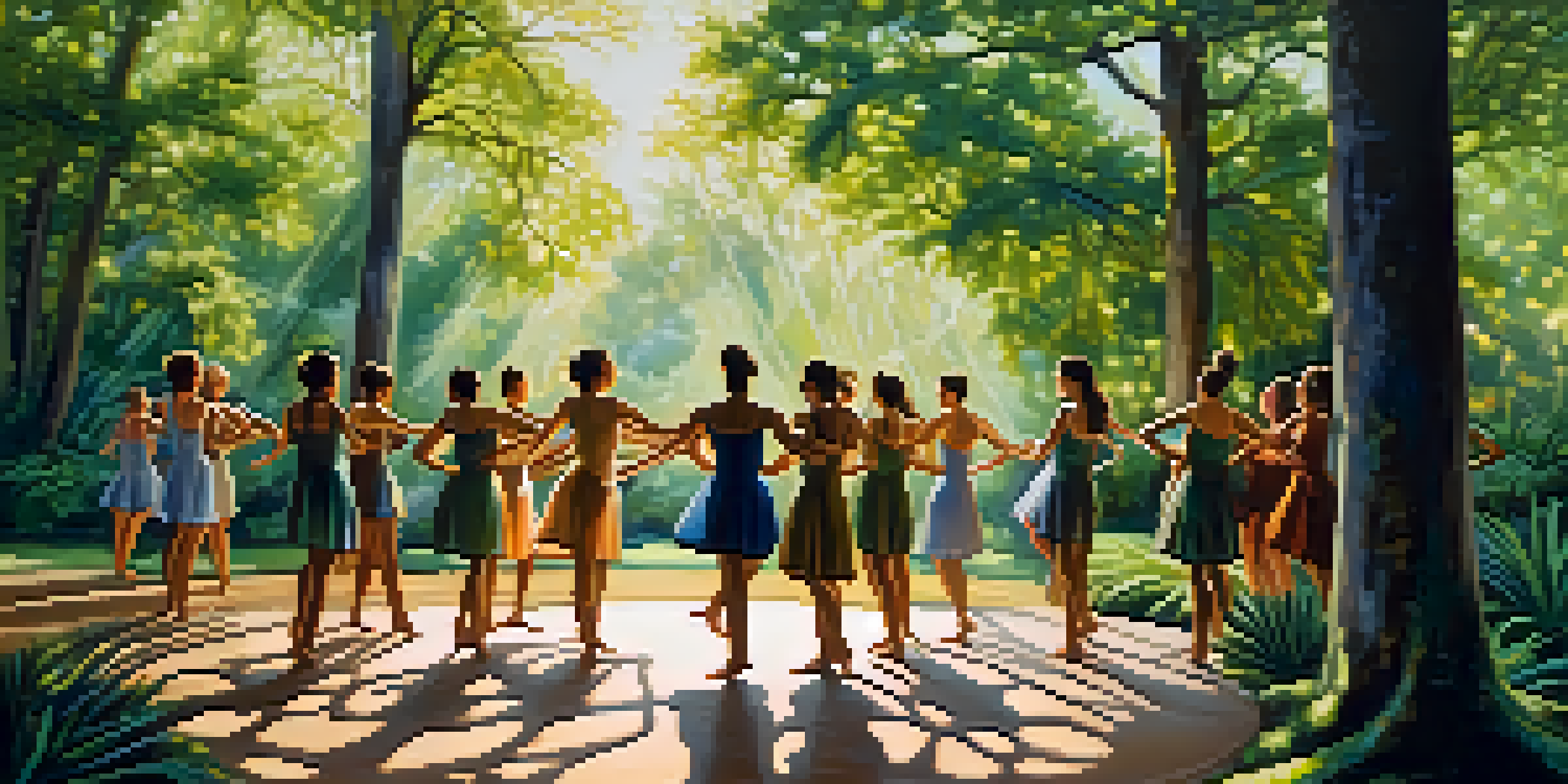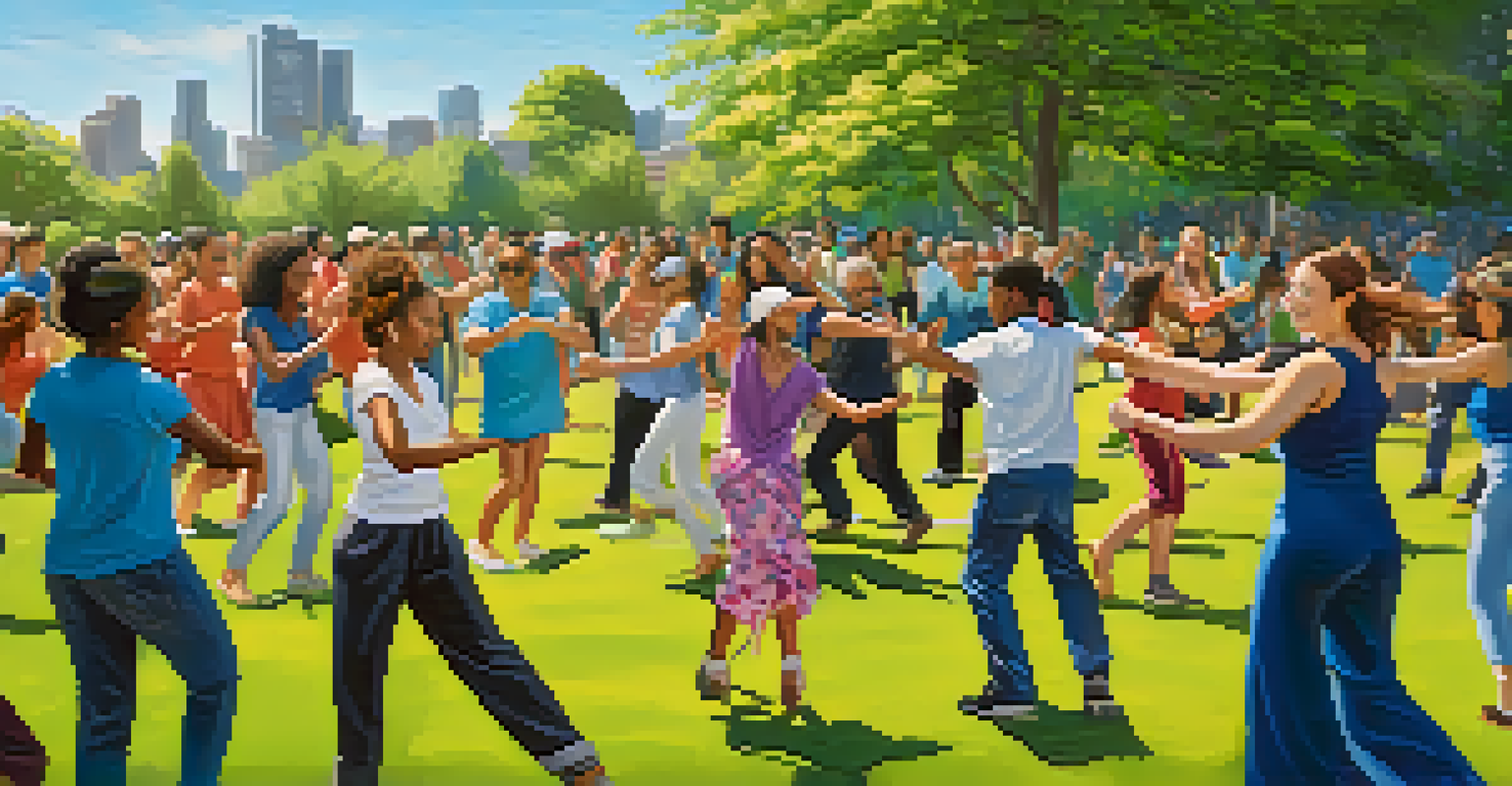Dance Movements Reflecting Environmental Change and Crisis

The Intersection of Dance and Environmental Awareness
Dance has long been a powerful medium for expression, and in recent years, it has become a poignant way to address environmental issues. Choreographers often draw inspiration from the world around them, using movement to reflect the beauty and fragility of nature. This intersection of art and activism encourages audiences to engage with pressing environmental concerns on a deeper level.
Dance is the hidden language of the soul.
For instance, many contemporary dance pieces incorporate elements that symbolize climate change, such as fluid movements representing rising seas or sharp, staccato gestures that evoke natural disasters. By embodying these themes, dancers not only tell a story but also invite viewers to reconsider their relationship with the environment. This engagement is crucial, as it transforms passive observation into active participation in the conversation about climate change.
Ultimately, dance can serve as a catalyst for change, urging individuals to reflect on their actions and understand the impact they have on the planet. As the world faces unprecedented environmental crises, the role of dance in raising awareness and inspiring action becomes increasingly significant.
Historical Context of Dance and Environmental Crisis
Historically, dance has been used to document societal shifts and environmental changes. From indigenous ceremonies that honor nature to modern performances highlighting industrial impacts, dance has chronicled humanity's relationship with the earth. This rich history shows how movement can serve as a record of our collective journey through environmental highs and lows.

In the 20th century, as awareness of ecological issues grew, many choreographers began to incorporate themes of environmental crisis into their work. Notably, pieces like 'The Rite of Spring' not only explored human sacrifice but also reflected the impending sense of doom surrounding industrialization and its effects on the landscape. These works have paved the way for today's artists to continue the conversation through their choreography.
Dance as Environmental Advocacy
Dance serves as a powerful medium to raise awareness about environmental issues, transforming artistic expression into a call for action.
By understanding the historical context of dance in relation to environmental change, we can better appreciate how contemporary artists continue to navigate these themes. This lineage of movement speaks to the timelessness of our connection to the earth and the ongoing struggle to protect it.
Choreography as a Response to Climate Change
Choreographers today are increasingly using their art to respond directly to climate change. Through innovative movements and storytelling, they express the urgency of the environmental crisis. For example, some performances might utilize contrasting movements to depict the tension between humanity and nature, highlighting the conflict and need for harmony.
Art is not a mirror to reflect the world, but a hammer with which to shape it.
One notable example is the dance project 'Dancing for the Earth,' where dancers collaborate with scientists to represent data on climate change through movement. This creative fusion allows audiences to visualize complex scientific concepts in a visceral way, making the data accessible and engaging. By marrying art with science, these choreographers create a powerful narrative that resonates deeply with viewers.
As these performances gain traction, they inspire both artists and audiences to consider their roles in addressing environmental issues. Dance becomes more than entertainment; it transforms into a form of advocacy that challenges us to take action and reflect on our impact on the planet.
Community Engagement Through Dance and Nature
Community-driven dance initiatives are emerging as a way to engage local populations in environmental issues. These programs often include workshops and performances that invite participants to explore their surroundings and express their relationship with nature through movement. This hands-on approach fosters a sense of belonging and responsibility towards the environment.
For instance, community dances might incorporate local environmental histories, allowing participants to connect with their land and its stories. By moving together, individuals can channel their concerns about environmental degradation into a collective expression of hope and resilience. This shared experience not only strengthens community ties but also empowers people to advocate for their environment.
Community Engagement Through Dance
Community-driven dance initiatives foster connections between individuals and their environment, empowering collective action for sustainability.
Furthermore, these initiatives can serve as a bridge between diverse groups, bringing together various voices to address common challenges. In this way, dance becomes a unifying force, reminding us that while we may come from different backgrounds, we share the same planet and the responsibility to protect it.
Dance as a Medium for Environmental Storytelling
Dance has a unique ability to convey stories without words, making it an effective medium for environmental storytelling. Through movement, dancers can express complex emotions related to nature's beauty and fragility. This non-verbal communication resonates powerfully with audiences, often evoking a visceral reaction that spoken words may not achieve.
Choreographers often develop narratives that reflect environmental themes, such as the loss of biodiversity or the struggle against pollution. These narratives can be interpreted in various ways, allowing viewers to connect personally with the message. For example, a dance piece might use slow, flowing movements to symbolize the delicate balance of an ecosystem, while sharp, chaotic motions depict the disruption caused by human activity.
By engaging with these stories, audiences can cultivate a deeper understanding of environmental issues. Dance not only entertains but also educates, inspiring individuals to reflect on their own interactions with the natural world and the impact they have on it.
The Role of Technology in Dance and Environmental Themes
As technology continues to evolve, so does its integration into dance, particularly in relation to environmental themes. Digital media, projections, and interactive elements can enhance performances, allowing choreographers to visualize data and narratives in innovative ways. This fusion of technology and dance offers new dimensions to the storytelling process.
For example, immersive performances might incorporate augmented reality to showcase the effects of climate change on specific landscapes. This combination of movement and visual media can create a more impactful experience, drawing audiences into the narrative and prompting them to reflect on their own roles in environmental stewardship. It transforms traditional dance into a dynamic dialogue that engages the senses.
Technology Enhances Dance Storytelling
The integration of technology in dance performances creates immersive experiences that deepen audience engagement with environmental themes.
Moreover, technology can facilitate broader outreach, enabling performances to reach global audiences through online platforms. This accessibility helps spread awareness and fosters a sense of global community in addressing environmental challenges. In this way, dance, enhanced by technology, becomes a powerful tool for advocacy and change.
The Future of Dance in Environmental Activism
Looking ahead, the future of dance in environmental activism appears promising and vital. As climate issues become increasingly urgent, more artists are likely to harness the power of movement to inspire change and raise awareness. This trend not only reflects a growing commitment to environmental issues but also highlights the role of the arts in shaping societal values.
Choreographers and dancers will continue to push boundaries, experimenting with new forms and styles to communicate their messages. Collaborations with scientists, environmentalists, and community leaders can further enrich this dialogue, creating multifaceted performances that resonate with diverse audiences. The adaptability of dance makes it an ideal medium for addressing the complexities of environmental challenges.

Ultimately, as we navigate an uncertain future, dance will remain an important platform for expression and activism. By engaging with environmental themes through movement, artists can inspire hope, foster resilience, and encourage collective action in the face of crisis.